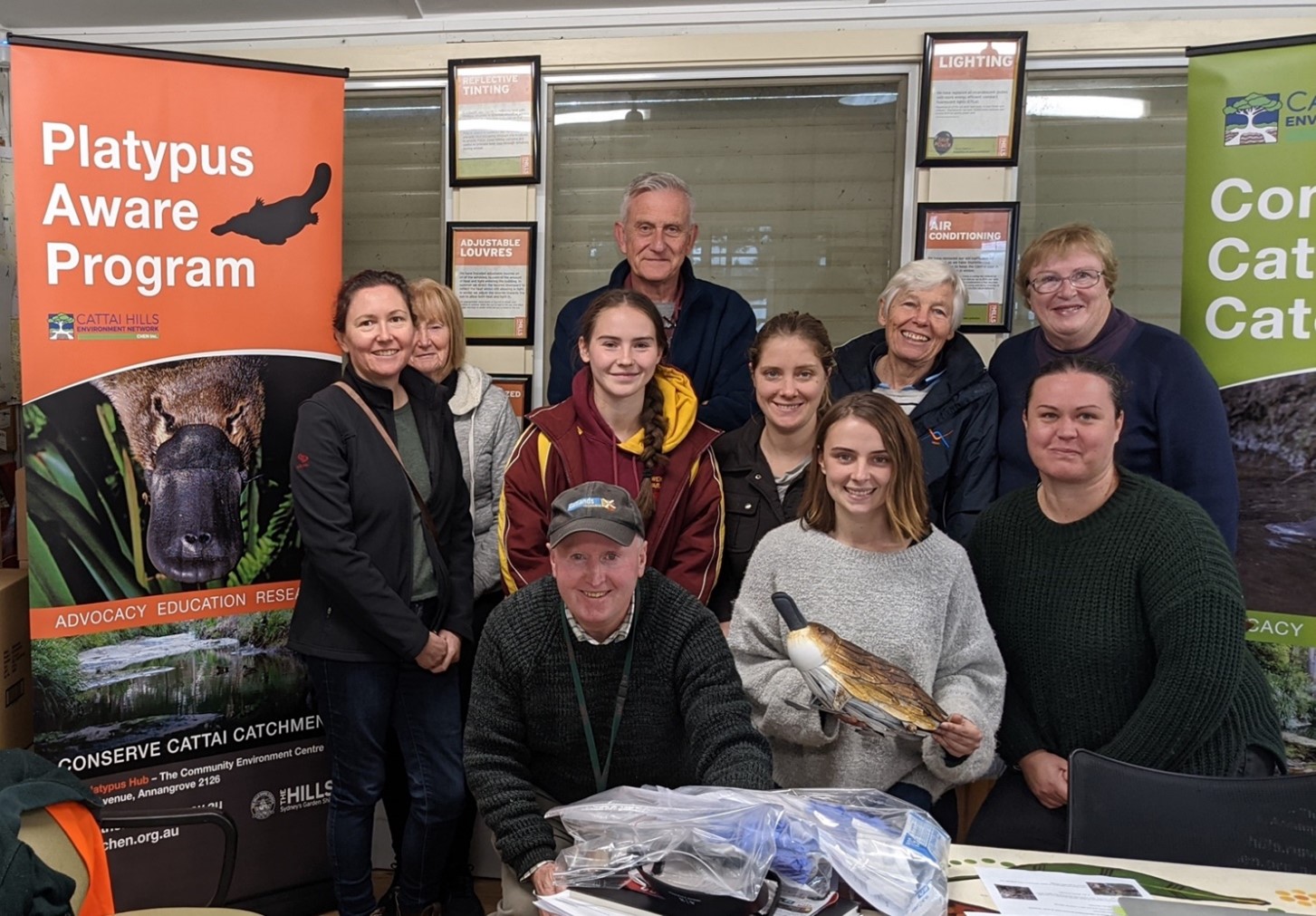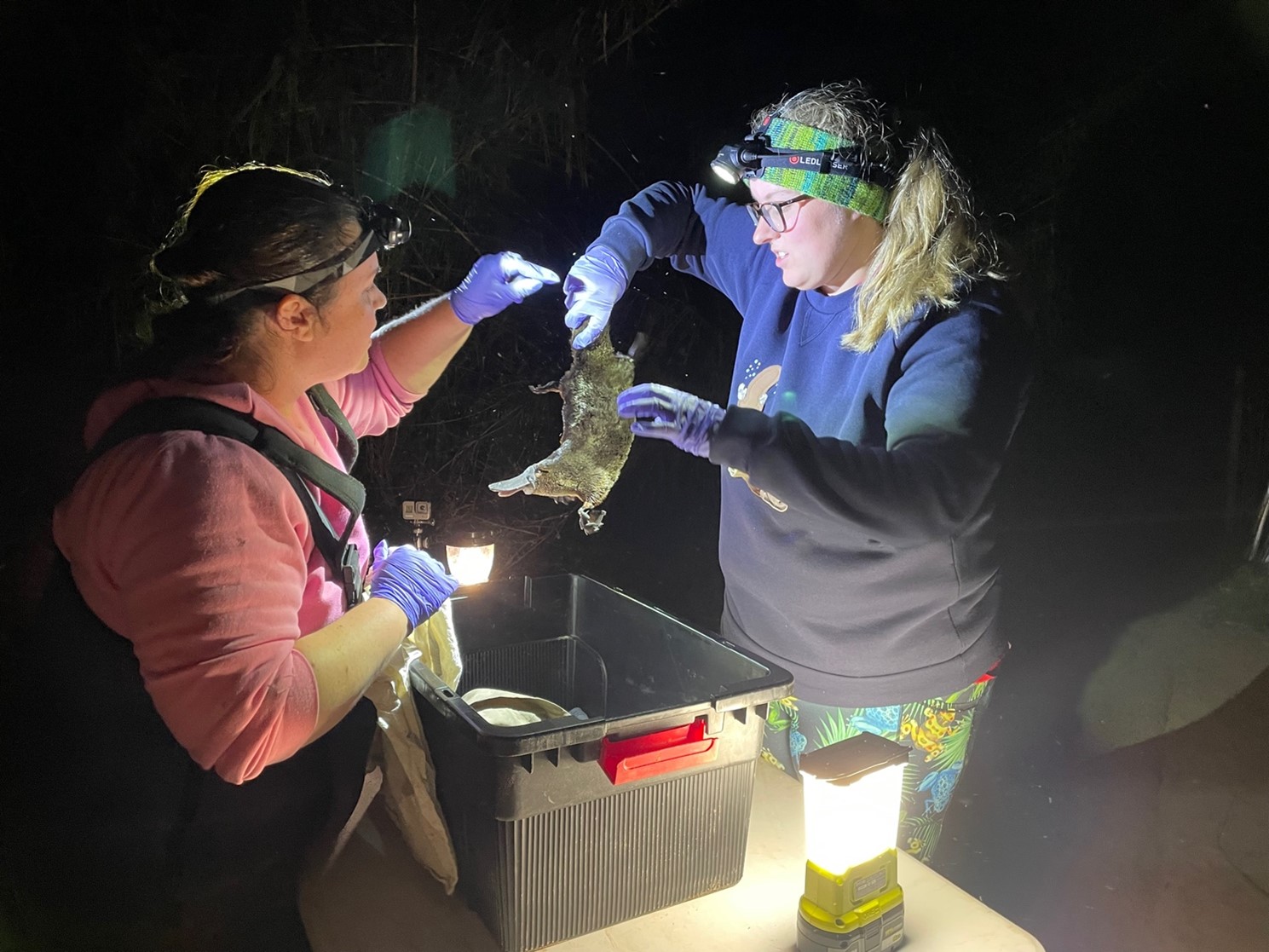5 Is this for real? Urban platypus in Western Sydney’s waterways


Hawkesbury Nepean Waterkeeper Alliance (HNWA)[1], and Michelle Ryan [2]
Keywords
Aquatic ecology; biodiversity conservation; riparian restoration; clean water; healthy waterways; platypus
The platypus excels at evolution
And displays a super cool solution
For making his way amidst the muck
He don’t run aground
He don’t get stuck.
Of this, the platypus would never dream
As a self-respecting monotreme.
Indeed, a platypus of station
Will employ electroporation.
The Marvelous Platypus ©2024. David Crandall, Posted on Poetry Soup,[3] owned by Arczis Web Technologies, Inc.[4]
Hawkesbury Nepean Waterkeeper Alliance Acknowledgement of Country
For the First Nations[5] of the Hawkesbury-Nepean River system, the lifeblood of Ngurra (Country) is water — physically and spiritually it binds together all living things. Caring for Ngurra has sustained generations of First Nations people and is vital to all that now rely on the health of its water. The Hawkesbury-Nepean Waterkeeper recognises the importance of First Nations cultural values of the River and advocates for caring for Ngurra that ensures Country is managed in a holistic and culturally respectful way – now and in the future.
No Way! Prove it!
There is a generally held belief that the elusive Australian platypus (Ornithorhynchus anatinus) make their homes far away from humans and our bustling cities and towns. When environmental activist, science educator and Chair of the Cattai Hills Environment Network (CHEN) Sue Martin met with local Hills Shire Council staff to advocate for waterway protection and platypus living in the urban creeks of North-Western Sydney’s development zone this was exactly the response: Is this for real? Community members and locals involved in Bushcare with intimate knowledge of the Cattai waterways in the Hills District had for years reported sightings of this iconic creature at the edge of urban Sydney. Community knowledge wasn’t enough, the council wanted verified data.
Sue then reached out and connected with Dr Michelle Ryan, an aquatic ecologist in the School of Science at Western Sydney University, Hawkesbury Campus.
| “When a platypus moves through water, when they scratch themselves, when they urinate, when they defecate, they’re leaving traces of themselves in DNA behind. With new technology scientists can now take a simple water sample, send it to a laboratory for analysis and confirm if there is platypus DNA in that sample” Michelle shares. |
With local community members Michelle and her team conducted two rounds of sampling- and with the first 18 samples, nine sites come back positive. With this scientific confirmation of platypus living in waterways in Sydney’s northern fringe for the first time since 1998. Cattai Creek community and research team set up nets and commenced a platypus catch-and-release monitoring program. As further confirmed platypus sightings in this area made their way into local and national media outlets, an urban platypus mania has been taking hold. This has spearheaded research across the urban fringes of Sydney from Hornsby to the Southern Highlands. Initial findings are that platypus are alive and well but in small numbers across this region. Councils, developer and commonwealth and state government as well as government instrumentalities such as Sydney Water are asking how can we do better for platypus and our waterways?

Small, mighty and uniquely adapted to Australian waterways
The reputation of the platypus is one of strangeness and weirdness, not easily categorised with confounding features: a bill like a duck, a tail like a beaver, and the capacity to lay eggs like a bird. The platypus is a monotreme with the females laying one to three eggs every few years in burrows on earthy river and creek banks up and down the east coast of Australia, Tasmania and Kangaroo Island. The males have a venomous spur on their hind legs that causes extreme pain for humans. Their webbed feet allow them to glide through the water, however they can bend these webbings back to waddle along quickly on their knuckles on land.
| “Another recent and obscure finding about platypus is that they exhibit photofluorescence. During COVID, people were walking around the British Museum with Ultra Violet torches and they found that the taxidermist platypus was emitting UV light back at them! We have tested with Western Sydney platypus we have caught and this phenomenon is now being researched,” says Michelle. |
The platypus being found across Western Sydney are quite small in size. The nestlings emerge from the burrows around February/March each year and start searching for their own territory. Platypus that have been captured and released range from 31 centimetres to 53 centimetres in length and weigh between 500 grams and 1.6 kilograms.
Platypus eat water bugs (macroinvertebrates). They have electric receptors in their bills which are extremely sensitive. They need to forage up to 14 hours a night and they have to eat up to about half their body weight each day. Platypus use their bills to find water bugs which live around rock cobbles, under logs and – being completely blind in the water they dive down using these receptors to track the signals from the bugs. They store these water bugs in their cheek pouches and then grind the bugs on a pad in their mouth and swallow.
The Hawkesbury Nepean Platypus Project and the HNWA
In New South Wales, platypus aren’t listed as threatened due to a lack of baseline data, especially in Western Sydney. The Hawkesbury-Nepean Platypus Project has been active for several years and is made up of a team of Western students and professional staff who are, coincidentally, a team of women passionate about waterway health. The project is supported by the HNWA which is a codesigned and codeveloped model of regional partners Greater Sydney Landcare (incorporating Streamwatch), Hawkesbury-Nepean Landcare, Cattai Hills Environment Network, Hawkesbury Environment Network, with Western Sydney University (Sustainability Education and Partnerships and the School of Science) dedicated to waterway health. The HNWA is endorsed by the International Waterkeeper Alliance a global grassroots movement dedicated to clean, drinkable, swimmable rivers with Dr Michelle Ryan as the nominated Waterkeeper. The platypus is the perfect flagship creature to raise awareness and implement river health programs.
Michelle’s research team have spent a long time training themselves to be able to undertake platypus netting where platypus are captured and data collected from them before they are released. Questions they ask are, where are the platypus found and what health and condition are they in? The team use specialist fyke nets that require a licence and proper training. These fyke nets have two wings located either side of a ring and – if the team is lucky – platypus swim into the ring. The team scoot the platypus out, transfer them into a dry pillowcase while they process them to make sure that they dry out completely, a sign of a healthy platypus. In 20 minutes, the team take all their measurements and assessments, check for spur measurements, check for entanglements, microchip and rerelease. The work is not for the faint hearted – it is cold, and can often yield no platypus, but the results are incredibly rewarding. The team catch not just platypus but also mullet, eels, and bullrouts indicating a thriving ecosystem.

Anthropomorphising and connecting with platypus
In the project, the team names all the platypus and do it for several reasons.
| “It’s a lot easier and more recognisable when analysing the data to call the platypus by name instead of a notated number. The second reason is that we usually have landholders or community members with us and they are the ones that name the platypus. This allows them to connect to that water body and that connection really helps people identify and want to protect the platypus and in turn protect the waterways and that’s what this research is all about,” says Michelle. |
Community members also like to name them after their creeks, so there is Fitz from Fitzgerald Creek and Bluey from Blue Gum Creek. We had some volunteers that named them after their children and family members. The team have added 65 new known locations of platypus to the scientific database of platypus in Western Sydney in Greater Sydney, which is really exciting.
Threats to Western Sydney platypus
Unfettered development: There is a plethora of development in Western Sydney with a huge amount of stormwater infrastructure. We need urban development that considers waterways, wetlands and creeks by addressing water sensitive designs, reducing concrete and using wetlands to filter sediments and stormwater.
Water litter pollution: Elastic bands, headbands and fishing lines can cause strangulation and death for platypus. Councils and different groups must conduct education programs, and litter removal programs to help protect those platypus populations.
Fish and Yabby Traps: Platypus needs to breathe air and can only be underwater three or four minutes, so they need to constantly rise to the surface. Closed top yabby and opera house fish traps are a death sentence. The program has recorded eight or nine that have drowned in these traps over the last few years.
Emerging contaminants: There are a number of sewage treatment plants that discharge into the Hawkesbury Nepean River and while phosphorus and nitrogen loads have been dramatically reduced, there are other emerging contaminants. HNWA research has shown there are three or four pieces of microplastics per three grams of sediment. Microplastics are tiny fibres, such as microbeads in facial scrubs, and fibres in clothes that go down the sink and end up at the sewerage treatment plant. While they are small, microplastics can end up in the aquatic food web including platypus. These can line its stomach and make the platypus feel full, causing starvation. Biomagnification has also been found to be an issue with emerging containments, with heavy metals and PFOS found inside platypus.
Five things a platypus really needs
This research is really exciting. A major finding is that it has identified the five things platypus in Western Sydney need:
- Tall trees in the riparian zone greater than five metres tall.
The roots of the trees help hold the bank together, a stable bank means platypus can safely burrow into it. Trees provide those roots, provide habitat for water bugs, which platypus needs, and also provide shade. We hear constantly about urban heat in Western Sydney and trees cool the ecosystem in our heat islands. In Kellyville and Penrith where we’re finding platypus, there are tall trees that assist keeping the creek cooler.
- Complex and rich riparian zone buffers
A wide riparian zone (the area between the river or creek and the land) from the river edge full of diverse types of vegetation (grasses, shrubs and trees), at least three metres and preferably 10 metres wide.
- Organic matter and woodland debris in creeks
This provides heaps of habitats for our water bugs and also assists the platypus to triangulate where bugs are. Platypus don’t need good quality (or high-scoring) water bugs, they just need an abundance.
- Overhanging vegetation and vegetation along the whole creek
The overhanging vegetation again provides habitat for water bugs, and, importantly, provides protection for burrows, especially from foxes and cats.
- Lack of sedimentation, silt and sand slugs
Platypus need clear water – controlling sediment and erosion from developments assists this.
The best is yet to come …
The HNWA and the secretariat at Western Sydney University has been successful in obtaining a $1m AUD Commonwealth Urban Rivers and Catchments Program funding to support the creation of platypus parks in three areas of the Hawkesbury Nepean catchment including local landowners with creek frontage. 60% of this funding dedicated to direct on-ground works and a strong Indigenous procurement and consultation component. For the platypus of Western Sydney, we hope the best is yet to come.
Call to action
Record Sightings
NSW BioNet[6]
Australian Platypus Conservancy[7]
Fishing line recycling bins
Campbelltown Council and others are putting fishing line bins out and staring public education and signage campaigns. Over 2.5 kilometres of fishing line has been collected so far[8]
Fish traps
Ozfish swap opera house traps over to platypus friendly traps[9]
Snip rings for wildlife!
Hair ties and elastic bands[10]
Streamwatch
Connecting people with waterway monitoring through citizen science[11]
SDG Alignment
The HNWA works across many of the “environmental” SDGs but recognises that this work would not be possible without the many valued regional partners, citizen scientists and people that make this possible.
SDG 6 – Clean Water and Sanitation
SDG 14 – Life Below Water
SDG 15 – Life on Land
Target 15.1
By 2020, ensure the conservation, restoration and sustainable use of terrestrial and inland freshwater ecosystems and their services, in particular forests, wetlands, mountains and drylands, in line with obligations under international agreements
Target 15.5
Take urgent and significant action to reduce the degradation of natural habitats, halt the loss of biodiversity and, by 2020, protect and prevent the extinction of threatened species
SDG 17 – Partnerships for the Goals
How to Cite this Chapter
Hawkesbury Nepean Waterkeeper Alliance (HNWA) & Ryan, M 2025, ‘Is this for real? Urban platypus in Western Sydney’s waterways’, in Boddington, E., Chandran, B., Dollin, J., Har, J. W., Hayes, K., Kofod, C., Salisbury, F., & Walton, L. (eds), Sustainable development without borders: Western Sydney University to the World, 2025 edn. Western Sydney University, Sydney. Available from https://doi.org/10.61588/TESB2263
Attribution
Is this for real? Urban platypus in Western Sydney’s waterways © 2024 by Hawkesbury Nepean Waterkeeper Alliance (HNWA) and Dr Michelle Ryan, Western Sydney University Senior Lecturer, Senior Lecturer in Ecology and Environmental Science. Collaboration with and support by Western Sydney University Sustainability Education and Partnerships, the University’s School of Science, Greater Sydney Landcare (incorporating Streamwatch), Hawkesbury-Nepean Landcare, Cattai Hills Environment Network, and the Hawkesbury Environment Network. is licensed under Creative Commons Attribution-NonCommercial-NoDerivatives 4.0 International https://creativecommons.org/licenses/by-nc-nd/4.0/deed.en
- Hawkesbury Nepean Waterkeeper Alliance, Western Sydney University, Australia ↵
- Michelle Ryan, Western Sydney University, School of Science, Australia ↵
- https://www.poetrysoup.com/poem/the_marvelous_platypus_1642542 ↵
- http://www.arczis.com/ ↵
- The First Nations that hold a deep and continuous connection to the Hawkesbury-Nepean River System across its catchment starting from its headwaters include, the Dharawal, Gundungurra, Dharug and Darkinyung Nations. There are other First Nations that hold a relationship to the river through kinship ties and obligations. ↵
- https://www.environment.nsw.gov.au/topics/animals-and-plants/biodiversity/nsw-bionet ↵
- https://platypus.asn.au/report-a-sighting/ ↵
- https://ozfish.org.au/2021/08/bcf-to-tackle-fishing-waste-with-new-rig-recycle-bins/ ↵
- https://ozfish.org.au/projects/yabby-trap-round-up/ ↵
- https://www.aws.org.au/snip-rings-for-wildlife/ ↵
- https://greatersydneylandcare.org/streamwatch/ ↵

